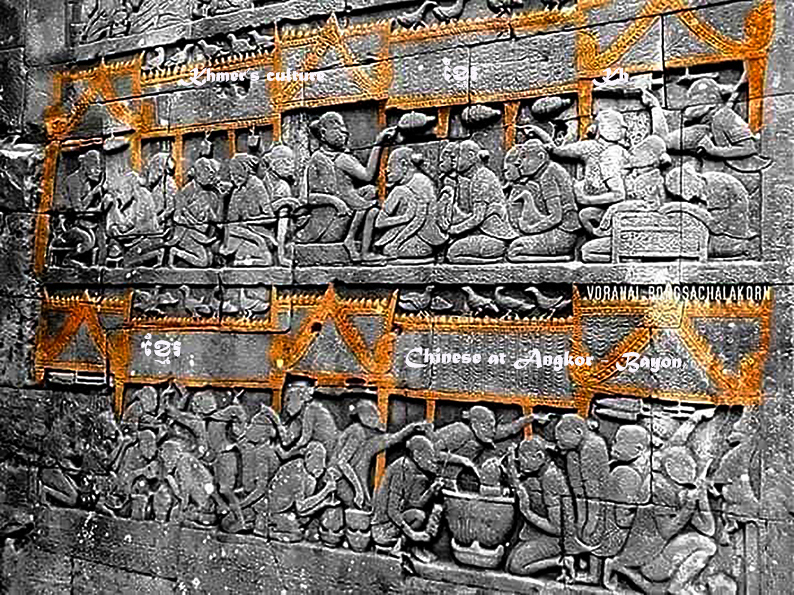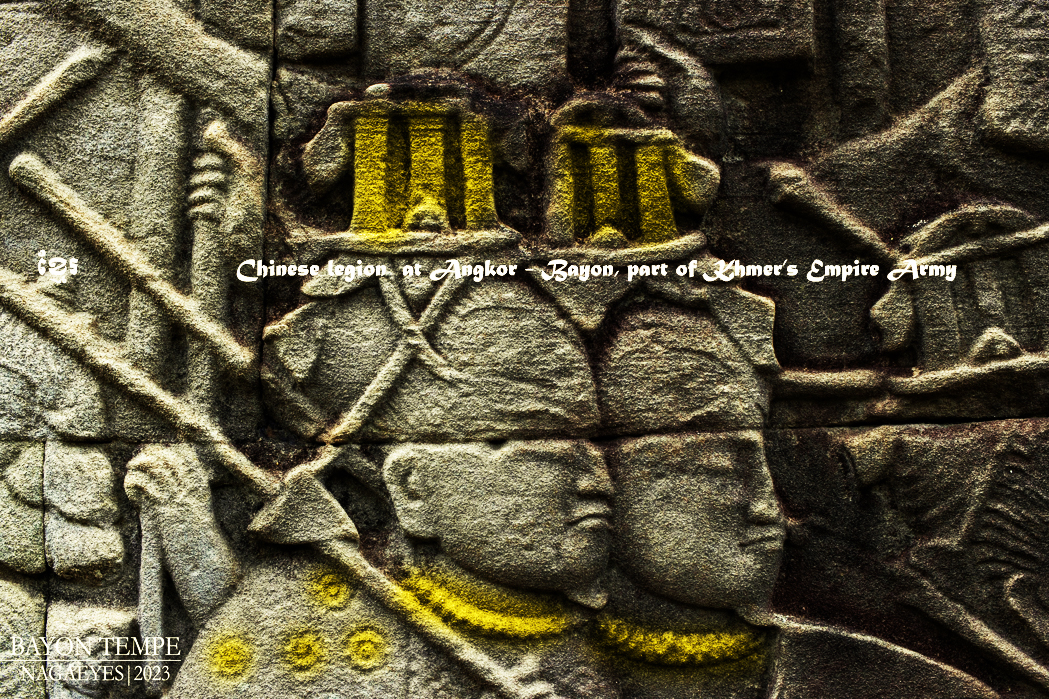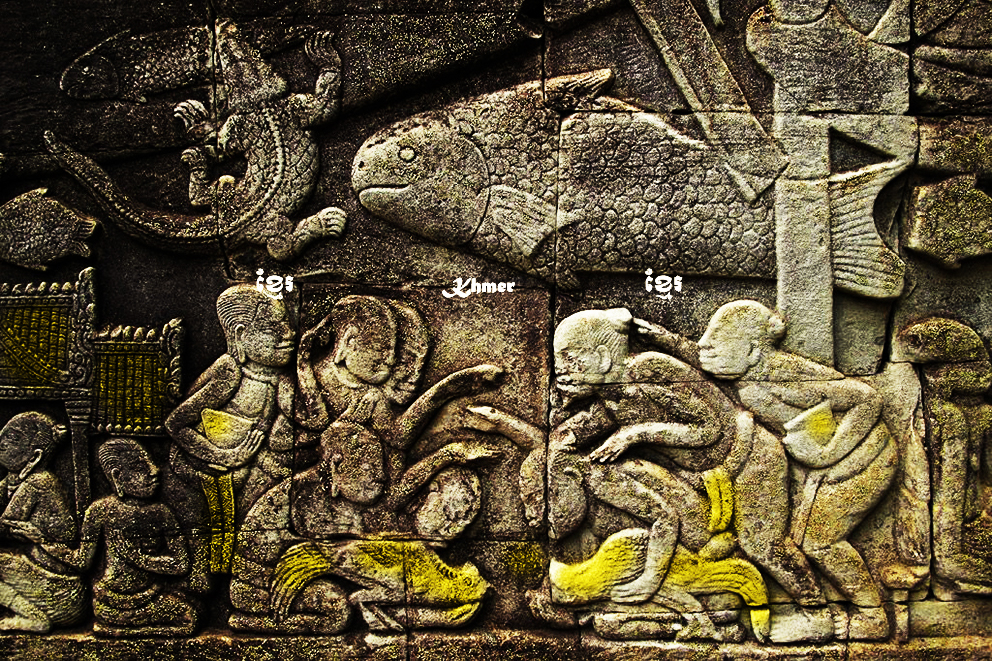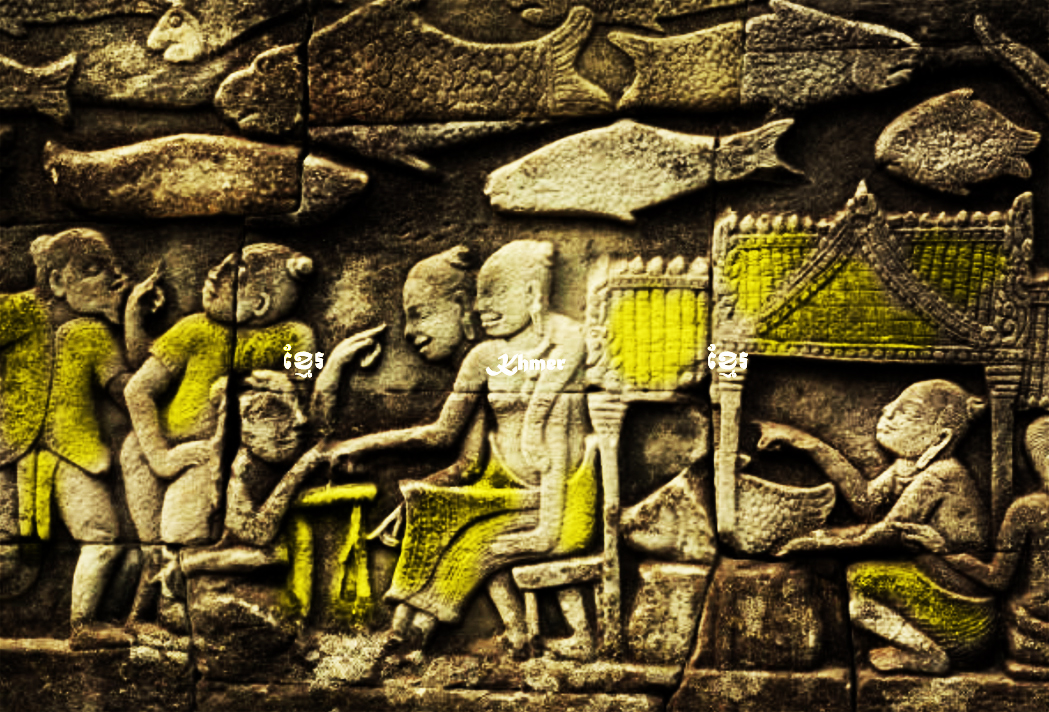| The powerful Khmer's army in action engraved on the walls of Khmer temples 1-2-3-4-5-6-7- Chinese warriors, tai japanese manchu at Angkor, Bayon bas-relief - tai qing mingmang, vn mingmang macu warriors, Tang and the stolen Khmer's artefact at Singapore's museum, Khmer's traditional food, busy cooking scence on Bayon carving, For political, cultural, economic or other reasons, it is rare to find foreign or Khmer’s scholarship documents referring to the massive settlement of Chinese communities on Khmer’s territory during the Khmer Empire. The lack of documents is a reason, but in terms of evidence, there is no shortage. On the walls of Angkor, the scenes of army procession showing Chinese troops marching along with different foreign legion and Khmer. The same scenes repeat along the Bayon’s wall carving to which we can observe the Chinese army marching in procession along with the Khmer army and other multi-ethnic legions. Theses impressive carving do not limit only to military procession but there are a lot of daily life scenes showing Chinese cookers, merchants, workers and other ordinary Chinese people playing and living along with Khmer. These indicate that during the Angkorian period, the Chinese played an important role in the Khmer’s Empire. In an inscription left by King Suryavarman I, mentioned the anger of Suryavarman I toward a nobleman named Tang. The inscription seems to indicate that King Suryavarman I was angry with Tang’s family because Tang has broken his vow of allegiance to King Suryavarman I who has offered Tang’s family his hospitality, land, wealth as well other privilege. But apparently, Tang has betrayed Him. He cursed the Tang family to perish in hell for eternity as the vow they made to Suryavarman I. Official Thai historical documents, which are generally almost completely distorted and falsified by Thailand, do not mention the Chinese presence in Ayutthaya during the Angkorian period, but in a rare document about the history of an ancient Khmer’s pagoda (Vat Phanam/Phnom Cheung) situated in Khmer’s ancient city Ayutthaya, recorded about the history of a Chinese temple built inside the pagoda Phanam/Phnom Cheung to commemorate a Chinese princess(Soi Dok Mak) who fell in love with a Khmer king (1). The princess waited for the king but he did not come to her as promised. Later, the Chinese princess died, and the emperor understood her devotion and trustfulness so he built a Chinese temple for her to remind her temple in her native land, China. The document also states that during the end of the 13th century, there were more than 200 Chinese communities living along Chao Praya liver and in Ayutthaya, an important Khmer’s ancient city. It's important to remind that, not only Chinese who come to settle on Khmer’s territory due to wars or other reasons but apparently, there’re also many other ethnics who come to install in Khmer’s Empire, these included the ancient Japanese manchus as shown on the wall of Bayon and Angkor. There’re a lot of fantasy and hypothesis related to a group of legion carving on the wall of Angkor during military parade to which mentioned Samkuk. Physically, that group of men resembled to Chinese men but not exactly like ordinary Chinese. Modern thai people claimed to be their kind or their ancestors but it seems that they are not. Some scholars like G.Coedes and his colleges from EFEO referred that group men Samkuk as black skin people while other attempt to refer them as Kasi people, a group of Khmer or Khmer-mon. Some other may refer them to the groups autochthone austro-malayo-indonesian who actually living in Indonesia and malayo golf like Dayak hari Gawai, Dayak merah, dayak-merah-jilah, dayak-merah-suku, Iban-sarawak, Jahut, Mah meri, murut, Orang Asli, Pasukan-merah-kawal ethnicrungus-kota-belud ect – But physically, the people considered as Austro-malayo-indonesia did not resemble to the Samkuk men on the wall of Angkor but rather like ancient Khmer who had populated the whole SEA to Malayo-indonesia and since pre-history While qing annexed more Khmer, Burma and Laos’s territory to Thailand, qing managed Thailand as its simple province. Qing emperor sent a new qing lotus seal to replace the ancient one on which mention siam king in Chinese. This new qing seal was use from rama1 to rama4 who has profited the decline of qing to replace Chinese seal by that of Khmer on which mention Khmer’s royal word “ Prah borom reach oka” in Khmer’s script. Rama4 led a hug cultural reformed from Chinese to Khmer. This cultural reformed was followed by his successors rama5 and rama6. It’s rama6 who had make Khmer’s version of Ramayana or Khol or khon in thai’s dialect, as part of thai’s identity which is now become a hug cultural conflict with Khmer as Ramayana or Khol in Khmer’s version and art was part of Khmer unique identity since pre-angkor period to now. The rama4 seal was used by his sucessors until 1940, date to which Thailand used a new seal with thai modern script instead of Khmer but keep the same initial design. On a Thai-Japanese sword museum dedicated to thai-japansese diplomacy and the military cooperation over the last 600 years, we can remark some horrible demonic Japanese warriors in their frightening horrible uniform and mask. 600 years seems to coincidence with the foundation of siam kingdom at mid14th. Weren’t those horrible warriors who along with Chinese song who led revolt against Khmer and detached two Khmer’s provinces to form primitive siam kingdom. |
 |
 |
 |
 |
 |
 |
 |
 |
 |
 |
Update Décembre 2023 |
| បណ្ណាល័យព្រលឹងខ្មែរ- 7 | 6 | 5 | 4 | 3 | 2 | 1 | ~ *~ 1 | 2 | 3 | 4 | 5 | 6 | 7 - បណ្ណាល័យព្រលឹងខ្មែរ |